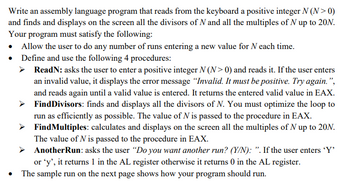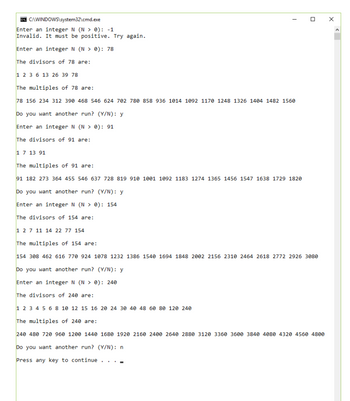
Write an assembly language
and finds and displays on the screen all the divisors of N and all the multiples of N up to 20N.
Your program must satisfy the following:
Allow the user to do any number of runs entering a new value for N each time.
Define and use the following 4 procedures:
ReadN: asks the user to enter a positive integer N (N > 0) and reads it. If the user enters
an invalid value, it displays the error message “Invalid. It must be positive. Try again.”,
and reads again until a valid value is entered. It returns the entered valid value in EAX.
FindDivisors: finds and displays all the divisors of N. You must optimize the loop to
run as efficiently as possible. The value of N is passed to the procedure in EAX.
FindMultiples: calculates and displays on the screen all the multiples of N up to 20N.
The value of N is passed to the procedure in EAX.
AnotherRun: asks the user “Do you want another run? (Y/N): ”. If the user enters ‘Y’
or ‘y’, it returns 1 in the AL register otherwise it returns 0 in the AL register.
The sample run on the next page shows how your program should run


Trending nowThis is a popular solution!
Step by stepSolved in 4 steps with 4 images

- Using python, please explain 1: A positive integer greater than 1 is said to be prime if it has no divisors other than 1 and itself. A positive integer greater than 1 is composite if it is not prime. Write a program that asks the user to enter an integer greater than 1, then displays all of the prime numbers that are less than or equal to the number entered The program should work as follows: Once the user has entered a number, the program should populate a list with all of the integers from 2 up through the value entered. The program should then use a loop to step through the list. The loop should pass each element to a function that displays the element whether it is a prime number.arrow_forwardProblem Ask the user for a positive integer N, then output the number of even and odd digits of N. The program should continuously ask input from the user until the user inputs a nonpositive integer (where the program must exit). Sample Run Enter n: 100 Even digits: 2 Odd digits: 1 Enter n: 31 Even digits: 0 Odd digits: 2 Enter n: 4286 Even digits: 4 Odd digits: 0 Enter n: 1234567890 Even digits: 5 Odd digits: 5 Enter n: -15 Goodbye! NOTE: You are not allowed to use string functions/operations, lists, tuples, dictionaries, or any other non-scalar objects.arrow_forwardWrite a Python program that will generate 1000 random numbers between 1 and 100 inclusive from the random generator. For each value returned from the random generator, keep a count of the number of even numbers generated and the number of odd numbers generated. Use the following functions within this program: - getRandom(): this function will call the random generator and return the generated integer value. - isOdd(): this function will return true or false depending on whether the number generated is odd or even. - update(): this function will update the counters for odd or even. - display(): once the program has completed 1000 random numbers, the counters for the number of odd and even will be displayed. REQUIREMENTS: - Add a beginning statement when the program starts to execute. - Add an ending statement when the program is complete. - Call the random generator 1000 times for a randomly generated number between…arrow_forward
- In python, write a program that receives an integer from the user, called n, and prints the first n prime numbers. For example, if the input is 7, the output should be: 2, 3, 5, 7, 11, 13, 17.arrow_forwardIn Java: Forms often allow a user to enter an integer. Write a program that takes in a string representing an integer as input, and outputs yes if every character is a digit 0-9. Ex: If the input is: 1995 the output is: yes Ex: If the input is: 42,000 or 1995! the output is: no Hint: Use a loop and the Character.isDigit() function.arrow_forward
 Database System ConceptsComputer ScienceISBN:9780078022159Author:Abraham Silberschatz Professor, Henry F. Korth, S. SudarshanPublisher:McGraw-Hill Education
Database System ConceptsComputer ScienceISBN:9780078022159Author:Abraham Silberschatz Professor, Henry F. Korth, S. SudarshanPublisher:McGraw-Hill Education Starting Out with Python (4th Edition)Computer ScienceISBN:9780134444321Author:Tony GaddisPublisher:PEARSON
Starting Out with Python (4th Edition)Computer ScienceISBN:9780134444321Author:Tony GaddisPublisher:PEARSON Digital Fundamentals (11th Edition)Computer ScienceISBN:9780132737968Author:Thomas L. FloydPublisher:PEARSON
Digital Fundamentals (11th Edition)Computer ScienceISBN:9780132737968Author:Thomas L. FloydPublisher:PEARSON C How to Program (8th Edition)Computer ScienceISBN:9780133976892Author:Paul J. Deitel, Harvey DeitelPublisher:PEARSON
C How to Program (8th Edition)Computer ScienceISBN:9780133976892Author:Paul J. Deitel, Harvey DeitelPublisher:PEARSON Database Systems: Design, Implementation, & Manag...Computer ScienceISBN:9781337627900Author:Carlos Coronel, Steven MorrisPublisher:Cengage Learning
Database Systems: Design, Implementation, & Manag...Computer ScienceISBN:9781337627900Author:Carlos Coronel, Steven MorrisPublisher:Cengage Learning Programmable Logic ControllersComputer ScienceISBN:9780073373843Author:Frank D. PetruzellaPublisher:McGraw-Hill Education
Programmable Logic ControllersComputer ScienceISBN:9780073373843Author:Frank D. PetruzellaPublisher:McGraw-Hill Education





